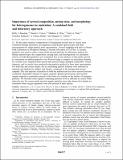Importance of aerosol composition, mixing state, and morphology for heterogeneous ice nucleation: A combined field and laboratory approach
Author(s)
Baustian, Kelly J.; Cziczo, Daniel James; Wise, Matthew E.; Pratt, Kerri A.; Kulkarni, Gourihar; Hallar, A. Gannet; Tolbert, Margaret A.; ... Show more Show less
Downloaddan paper 3.pdf (682.6Kb)
PUBLISHER_POLICY
Publisher Policy
Article is made available in accordance with the publisher's policy and may be subject to US copyright law. Please refer to the publisher's site for terms of use.
Terms of use
Metadata
Show full item recordAbstract
In this study chemical compositions of background aerosol and ice nuclei were examined through laboratory investigations using Raman spectroscopy and field measurements by single-particle mass spectrometry. Aerosol sampling took place at Storm Peak Laboratory in Steamboat Springs, Colorado (elevation of 3210 m). A cascade impactor was used to collect coarse-mode aerosol particles for laboratory analysis by Raman spectroscopy; the composition, mixing state, and heterogeneous ice nucleation activity of individual particles were examined. For in situ analysis of fine-mode aerosol, ice nucleation on ambient particles was observed using a compact ice nucleation chamber. Ice crystals were separated from unactivated aerosol using a pumped counterflow virtual impactor, and ice nuclei were analyzed using particle analysis by laser mass spectrometry. For both fine and coarse modes, the ice nucleating particle fractions were enriched in minerals and depleted in sulfates and nitrates, compared to the background aerosol sampled. The vast majority of particles in both the ambient and ice active aerosol fractions contained a detectable amount of organic material. Raman spectroscopy showed that organic material is sometimes present in the form of a coating on the surface of inorganic particles. We find that some organic-containing particles serve as efficient ice nuclei while others do not. For coarse-mode aerosol, organic particles were only observed to initiate ice formation when oxygen signatures were also present in their spectra.
Date issued
2012-03Department
Massachusetts Institute of Technology. Department of Earth, Atmospheric, and Planetary SciencesJournal
Journal of Geophysical Research Atmospheres
Publisher
American Geophysical Union (AGU)
Citation
Baustian, Kelly J. et al. “Importance of Aerosol Composition, Mixing State, and Morphology for Heterogeneous Ice Nucleation: A Combined Field and Laboratory Approach.” Journal of Geophysical Research 117.D6 (2012). ©2012. American Geophysical Union.
Version: Final published version
ISSN
0148-0227
2156–2202